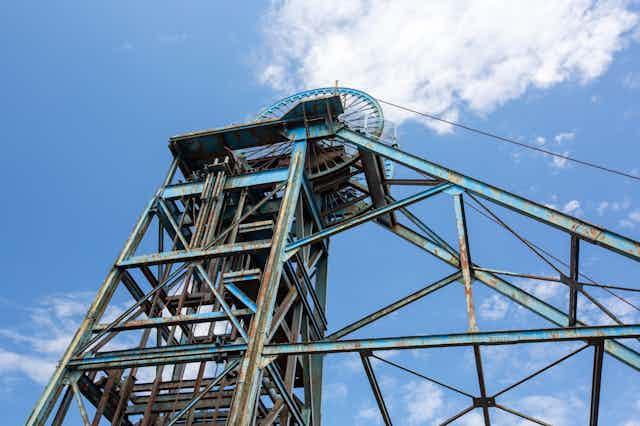West Cumbria suffered a “once-in-a-thousand-year” flood in 2009. And then again in 2015. And 2019. No, it’s not that meteorologists can’t count. Climate change is increasing the risk of precisely the kind of intense downpours that triggered these floods, so that once-freak weather events now happen far more regularly.
West Cumbria and climate change are in the headlines again, but for a different reason: the local council’s approval of the Woodhouse Colliery, the first deep coal mine to open in the UK for over 30 years, which it’s now reconsidering “in light of new information on proposed greenhouse gas targets for the 2030s”. Scientists, climate policy experts and campaigners had argued the mine was inconsistent with the government’s own aim to reach net zero greenhouse gas emissions by 2050.
But there could be a way to transform this potential embarrassment during the run-up to the Cop26 climate conference, into a flagship project for the world’s net zero future.
Woodhouse Colliery
Cumbria’s Woodhouse Colliery would produce coking coal, which fuels the blast furnaces in steelworks. Unlike thermal coal, which is used to generate electricity but is struggling to compete with renewable energy, coal-based steel-making is still significantly cheaper than alternatives such as hydrogen. It may still make sense to use coking coal in blast furnaces in a world with net zero greenhouse gas emissions – provided, of course, they are fitted with robust carbon dioxide capture and storage technology, and any leakage is recaptured from the atmosphere.

West Cumbria Mining (WCM), the mine operator, argues that coking coal will be used somewhere in the world for the foreseeable future, so if it nobly decides to leave its carbon in the ground, the planet won’t really benefit. But by selling coal for conventional blast furnaces, the company would be responsible for 250-odd million tonnes of carbon dioxide over the next 30 years.
If such a mine were to go ahead, there’s an opportunity to show the world what a net-zero-compliant fossil fuel industry could look like with a simple provision in its final planning approval. WCM has already agreed to dispose of mine waste underground. Why not simply add that, by 2050, every tonne of carbon dioxide generated by mining and burning the coal they sell must be disposed of as well, safely and permanently?
Net-zero-compliant coal?
WCM might shrug and agree, noting that their operating license only runs to 2049 anyway. But promising to close down in 2049 doesn’t make a coal mine consistent with a net zero world in 2050 if the plan is to continue selling fossil fuels right up to the last minute. Achieving net zero emissions by 2050 means starting the transition now. To limit global warming to 1.5°C global emissions must start to fall immediately, and 10% of the carbon dioxide generated from the continued use of fossil fuels must be injected back into the Earth’s crust by 2030, with 50% injected by 2040 and 100% by 2050.
Another option is storing the carbon in Cumbria’s peatlands or native forests. Restoring and protecting these natural carbon sinks is important for lots of reasons, including supporting biodiversity, alleviating flooding and creating associated jobs. It would also be much cheaper per tonne than injecting carbon dioxide below ground. But restoring and sustainably managing all the UK’s peatlands would take up only 60% of the carbon dioxide released by the Woodhouse Colliery’s coal by 2050. Climate change could turn these ecosystems into sources of emissions too, as soils warm and wildfires become more frequent. So in the long term, the bulk of remaining emissions will need to go underground.
WCM could deliver this by working with its customers, such as the British Steel plant in Scunthorpe, to capture the carbon dioxide produced by their blast furnaces and dispose of it under the North Sea through the Zero Carbon Humber project.

Disposing of a small percentage of total emissions would only add a few pounds to the cost of a tonne of coking coal at first, but as this percentage rises, WCM would need the government on their side, insisting that if Britain is to sell net-zero-compliant coking coal, then the rest of the world should do the same. And as WCM runs out of UK-based steel mills on which to fit carbon capture technology, they could shift to capturing carbon dioxide directly from the atmosphere and pumping it under Morecambe Bay, one of the UK’s best prospective storage sites. And so a new product, net-zero-compliant steel, and a new industry, is born.
WCM’s backers, Australia-based EMR Capital, might baulk at the suggestion they should take responsibility for the emissions generated by the products they sell. Which would reveal what the coal industry really thinks about its future in a net zero world. Or they might agree to go ahead anyway, creating many more than 500 jobs in the north of England, and demonstrating a long-term business model for both the fossil fuel industry and all the investments being made in carbon capture and nature-based solutions.
We initially thought that trying to calculate what it would take to make the Woodhouse Colliery consistent with Britain’s commitment to net zero emissions by 2050 would show the whole plan isn’t viable. But looking at the numbers, we’re not so sure. If EMR Capital does pull out, there are vast pools of capital still invested in the fossil fuel industry, held by investment funds claiming to be committed to net zero by 2050 but unsure how to square the circle. Time for Cumbria to call in some chips.

